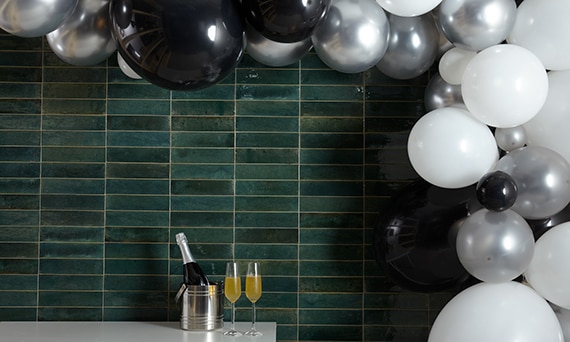
CARING FOR & MAINTAIN PORCELAIN
Routine Care and Cleaning
Regular, basic cleaning with warm water and mild soap is sufficient to keep floors looking good. You can also use gentle, everyday multipurpose spray cleaner to remove soap scum, hard water deposits, and mildew. Do not use cleaning products that contain acids or ammonia (and other harsh chemicals) as these can damage grout and glazed surfaces of the tile. Choose products that are compatible with your grout to avoid damage or discoloration of the grout. Always dry your porcelain thoroughly after cleaning.
Unglazed tile should be cleaned routinely with concentrated tile cleaners that have a neutral pH. These cleaners are better suited for removing grease, oils and normal spills from unglazed products.
StepWise™ Product Care
StepWise is a technology infused into tile that makes it 50% more slip resistant than regular tile. Products with StepWise do not require any specialized care. They can be cleaned and maintained as you would any porcelain surface.
Preventing Stains and Scratches
While porcelain is resistant to scratches, etching and stains, these surfaces are not damage proof. Take care to avoid exposing porcelain to permanent inks or dyes, as these might not be removable. If porcelain surfaces are exposed to permanent marker or dye, rinse the area with water as soon as possible then apply approved cleaning product. Rinse and dry thoroughly. Although porcelain is resistant to stains from juice, wine, coffee and other food substances, it is best to wipe up spills immediately to prevent possible stains.
When chopping vegetables, slicing bread or preparing other foods with sharp utensils on a porcelain countertop, use a cutting board. Use cleaning products and implements that are non-abrasive. Additionally, sweep or vacuum tile prior to cleaning to remove dust or debris.
Protecting Porcelain Surfaces
Porcelain does not require sealing, however, it is a good idea to seal grout or any joints. Use a product that is safe for both the tile and the grout.
To remove sealers, waxes and other floor finishes from porcelain tile or countertops, use a tile sealer and adhesive remover. Always test a small area first. Apply a liberal amount of undiluted sealer and adhesive remover in a manageable area. Allow it to sit without drying until sealer residues on the surface soften. Reapply if necessary until sealer softens and can be removed by wiping off with a cotton towel or sponge. If necessary, agitate with a nylon scrub pad. Rinse thoroughly with clean water. Do not use on tile or grout sealers on natural stone products.
Grout Care
The purpose of grout is twofold, to fill the joint between the tiles and to provide a space for tile to flex. It decreases breakage of tile and becomes a permanent, integral component of the finished installation. Grout is one of the more difficult parts of maintaining a porcelain tile floor. It tends to capture dirt and darkens over time. It requires more specialized cleaning and maintenance than tile.
Installation
Immediately after tile has been installed and grouted, the new installation should be covered with brown paper (to protect it from debris and allow for moisture evaporation) during any remaining construction. The grout joints should be dampened daily with clear water using a clean sponge or mop during the first seven days. This procedure facilitates the grout cure and helps it retain its color better.
Haze is a film that is left behind on the tile after it has been grouted. This can easily be buffed off the surface after the grout has cured 12-24 hours with a sulfamic acid-based grout haze cleaner. It can be purchased in powder form and mixed with water to the appropriate strength. This type of cleaner breaks down the cementitious grout haze. If your grout is epoxy-based, epoxy haze cleaners are formulated for this different form of grout. Both haze cleaners are safe for grout and tile but should not be used on natural stone.
For tips selecting the right grout color or hiring a tile installer, check out HGTV star Chip Wade's tips.
Sealing
Cementitious grouts should be sealed after installation. A penetrating/impregnating sealer that does not contain silicone is effective in grout’s resistance to spills, stains and moisture absorption and can help it retain its original color better and decrease maintenance. Sealers should be reapplied regularly to grout (glazed tile does not need to be sealed). Some sealers will last several years (see product information, and warranties) but frequency will also depend on traffic patterns and maintenance routines. Grout should be sealed 72 hours after installation.
Epoxy grout is chemically cured and doesn’t require the sealers that cementitious grouts do. They are naturally resistant to spills, stains and moisture.
Cleaning
Grout needs to be cleaned on a periodic basis to remove any surface buildup. Routine grout cleaning can be done with a daily concentrated household or commercial cleaner depending on the application. When heavy-duty grout cleaning is required, you will need to use a professional strength tile and grout cleaner that is capable of removing grease, soap scum, oils, mildew stains, algae, and synthetic or acrylic waxes from the grout joints. Select a product that does not contain polluting chemicals and is low VOC. This type of product can be purchased from most home centers, or through your local, professional floor covering dealer. You might also consider professional grout cleaning companies.
Grout Restoration
When grout has been stained to the point that it cannot be maintained or returned to its natural color, you can use a "grout stain." Grout stains are epoxy-based products that are specifically designed to penetrate into the grout and seal the surface with a permanent color. Once the grout has been stained there is no need to seal it any further with a penetrating/impregnating sealer. Prior to staining, the grout joint should be cleaned thoroughly to remove any dirt, oils, grease or sealers with a professional strength tile and grout cleaner. This can be purchased from most home centers or through your local professional floor covering dealer.
Disclaimer
CARE AND MAINTENANCE GUIDE
Dal-Tile does not manufacture installation products or countertop cleaning/maintenance products. Dal-Tile provides the information on this page to its customers as an information source only. Please contact an installation product manufacturer directly, prior to usage, to obtain proper handling instructions, application instruction and warnings concerning potential health hazards for any product contemplated for use.
To ensure your products will provide you with a lifetime of beauty and utility, proper maintenance is crucial. Natural stone products are porous by nature and require a different maintenance program than traditional ceramic tile. Dal-Tile also strongly recommends testing a small area PRIOR to usage of any installation/cleaning/maintenance product to determine whether the product serves its intended purpose.
SAFETY PRECAUTION TO CUSTOMERS
The products described in this document may have chemicals that cause reactions in certain individuals. Dal-Tile strongly recommends the use of safety glasses, respirators (masks) and gloves in handling any materials that contain chemicals. Dal-Tile recommends the proper disposal of any scrap tile/stone, installation and/or maintenance products discussed herein.
Additional Resources
How to install
tile
Experience how easy tile installation can be with step-by-step tips from our experts.
Choosing
the Right Tile
Picking the right tile should not be difficult. We have outlined key information to help.
Frequently Asked Questions
Learn from the experts as they answers a wide array of commonly asked questions.
Factors to Consider
Knowing these technical details can help you make the best choice when selecting tile.





